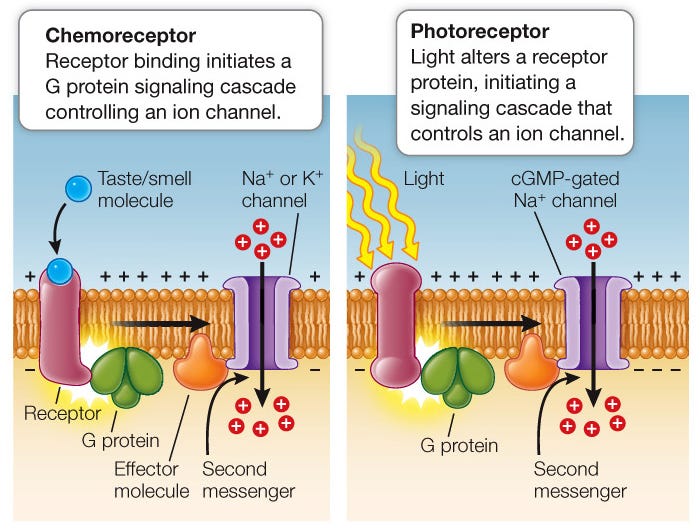In the US, this week is Thanksgiving. It's time to reflect and give thanks for all the things we take for granted. Often, the things we fail to appreciate are the things that are so ubiquitous in our lives, we don't even realize they exist, let alone how essential they are.
Of course, I'm talking about parts of our neural processing.
One of the central lessons from robotics and machine learning is how difficult some of the tasks are that our nervous system does so easily.

The great thing about needing to build something from scratch is there's no cheating—if your robot doesn't have a system for doing the thing, it doesn't have the ability to do the thing. Until you try to build something, it's easy to have an oversimplified image of what would be involved in having an autonomous robot.
For example: how many senses do we have? If you said five, it's because Aristotle was a dingus—he's the one that articulated the five senses framework and for some reason that vestige of pre-modern science hasn't gone away.
We have more than five senses. For example, we have the ability to detect temperature. This involves completely different sensory cells and receptors than the classic five senses.
So there you have it, we found the sixth sense.

Exactly how many senses we have depends on how you classify them. A reasonable number might be ten: sight, hearing, tactile (touch), smell, taste, temperature, pain, balance, proprioception (awareness of the location and movement of our body parts), and interoception (feeling our internal body states—the ability to sense needing to pee, for example). But this is a bit arbitrary—we could group some of these together or split them up further if we wanted.
How many senses we have comes down to how you slice things—you could break many of these senses down further to get more specific senses (for example, our sense of vision allows us to sense light vs dark but also red vs green). You could argue we have 33 senses.
Heck, you could decide to group together some of the senses we usually separate. Hearing, for example, uses the same basic mechanisms as our sense of touch. Smelling and taste are both just ways to detect specific chemicals. It isn't crazy to classify them as the same sense.
The way we classify senses isn't someone just deciding what seems "sense-y" enough to consider a sense.
Generally, the way a neuroscientist determines whether something is a sense is based on whether there is a group of sensory cells that respond to a specific physical phenomenon that send their signals to a specific brain region.
You might notice I snuck the phrase "sensory cells" into the above definition and you might be worried about circularity. If so, chill out and stop being so pedantic. I'll talk about that in a bit.
Back to giving thanks: we take some of our senses for granted, which is probably why we don't second-guess the usual list of five senses. We don't think of proprioception, our ability to sense where our body parts are in space, as a sense. Yet we have specialized sensory cells transmitting that information to our brain constantly. It just seems natural that of course we would know where our body parts are.
Let's take a moment to learn about how our senses work so we can properly give thanks for them.
What makes neurons talk
For neurons, sensory or not, the primary way they process information is by moving ions around. Ions are electrically charged molecules. By changing the concentration of ions, neurons change the electrical charge inside themselves.
Normally, neurons maintain a slightly negative charge—they have more negative ions than positive. They do this with active mechanisms on their membrane that "pump" ions in and out of the cell (literally called ion pumps).
By maintaining a negative charge, the neuron creates something interesting—all it needs to do is open up a passageway, and positive ions will flood in to equalize the imbalance.
Most of how neurons process information is by opening up passageways in their cell membrane in different ways.
When a neuron's charge becomes a bit more positive, it crosses a threshold and undergoes a rapid spike in electrical charge called an action potential (this rapid shift is also caused by ion channels, these ones gated by electrical charge itself). Action potentials (or the firing of the cell) are what we usually think of when we talk about neural activity. They're the primary way neurons talk to each other.
We usually think of neurons as wired up together, passing electrical signals to each other. They actually don't (usually) directly send electrical signals. Instead, the action potential of a cell triggers the release of neurotransmitters into the synapses (the gap between two connected neurons), where it's taken up by the downstream neurons. These neurotransmitters activate special receptors on the receiving neuron, opening up channels, and allowing ions to flow through.
So when we talk about the electrical activity of neurons, we're really talking about ions. When neurons transmit information, they do so by coaxing downstream neurons to open up their channels and letting ions in.
The cool thing is, opening (or closing) of ion channels isn't just the mechanism used for neurons to talk to each other, it's also how specialized neurons (sensory cells) gather information about the outside world.
How sensory cells detect the world
The trick to understanding the senses is to understand that sensory cells just have specialized receptors controlling their ion channels.
For example, in our noses and tongues we have sensory cells with chemical receptors. These are channels that open only for specific chemical structures, like a lock-in-key. When that chemical makes contact with one of these receptors, the channel opens up, causing ions to flood in. That's how our noses and tongues detect the presence of a chemical (smell and taste).
Photoreceptors are similar—they have an enzyme that reacts to photons, initiating the process that controls an ion channel. In the case of photoreceptors, they actually close the channel rather than open it, but the same principle is at work: changing the flow of ions, whether inhibiting it or allowing it, changes the electrical signal.

Thermoreceptors (the receptors that detect temperature) change shape in different temperatures, opening when certain temperatures are reached, allowing or inhibiting the flow of ions based on heat.
To me, the funniest sensory receptors are mechanoreceptors. These receptors just work on basic mechanical principles. The ion channels are literally either stretched open or attached by little hairs to something that tugs them open when it's moved. This is how touch works (hearing as well—more on that below).
Pain, hearing, and balance
The receptors described above are the mechanisms behind all our senses. Some of our senses just use these types of receptors in different ways.
For example, we have separate cells for pain, but they use all the same receptor mechanisms—nociceptors specifically respond to extremes in pressure or temperature and only signal if they detect such an extreme. They also have some receptors for certain damaging chemicals.
Our sense of hearing is the detection of a mechanical force—air vibration. In the ear, the vibration in the air is transformed into a vibration through liquid in the cochlea. The sensory cells that detect this vibration, hair cells, are really just mechanoreceptors. They have structures that look like little bundles of hair (hence the name). Those bundles sway in the current of the liquid in the cochlea, the mechanical movement causing the ion channels to open and create an electrical current.
It's ridiculous how this actually works. The bundle of hairs have little strings attached to each other that link up with the ion channels, so when they start to sway, the string literally just opens up the channel physically:
The idea that there's just little strings opening up the channels seems like a kludgy design to me, but I guess hearing works pretty well so what do I know, I've never designed a nervous system.
Hair cells swaying in a liquid is also how our vestibular system, essential for balance, works—our inner-ear has semicircular canals filled with liquid that sloshes around when we rotate our head. Hair cells pick up the movement of that liquid, signaling the rotational movement. When we spin in circles, we get dizzy because the liquid takes a bit of time to settle after the intense rotation.
The more interesting part of our vestibular system in my opinion is the part that senses forward or backward movement (instead of rotation). Also part of our inner ear, the otolith organs are filled with tiny rocks of calcium carbonate. When there is forward or backward movement, the rocks move around, disturbing a membrane that—once again—moves hair cells, signaling the movement.
Exercise for the reader: Create a joke about how in our head there are rocks that move when we rock our heads to rock music. Make sure it isn't cringeworthy. (This exercise may be impossible).
Giving thanks to our neglected proprioception
I suspect proprioception is the sense the average person thinks about least.
We have sensory cells throughout our muscles, tendons, and joints, all with the purpose of detecting the position of our own bodies. Proprioceptors use the same principles of mechanical ion channels mentioned above—ion gates open or shut based on physical stretching or moving.
This might sound silly—surely we know where our own bodies are!—but our own blindness to the necessity of the proprioception system is the point I want to highlight here.
We don't realize how essential proprioception is because it's invisible to us—we always have it. Like a fish that doesn't know what water is because it's always present, we're unaware of how essential proprioception is because we never experience the world without it.
We can close our eyes, cover our ears, wear heavy gloves—we know what it means to lose our canonical five senses. We can even spin in circles to make ourselves dizzy, giving us a sense of how difficult it is to walk without a properly functioning sense of balance.
But being without the ability to sense where our own body is just isn't something we experience.
If we're lucky.
Ian Waterman is one of few people we know of who lost his proprioception. After extensive rehabilitation, he managed to relearn how to walk, but doing so requires him to visually track his feet and maintain concentration on what they're doing. The effortlessness with which we navigate the world and use our limbs isn't possible for him.
So this Thanksgiving, let's give thanks for the things we overlook. The things that are so ubiquitous we take them for granted. Our complex sensory systems that allow us to interact with the world, the infrastructure that makes our modern homes possible, the global supply chains that we rely on for food and goods.
Maybe there's someone in your life whose support is so ever-present, you don't often stop to appreciate that it's what makes it possible to navigate your life. Who is the proprioception in your world?
(Thank you, Carrie)
You can show your thanks for Cognitive Wonderland by hitting the ❤️ “Like” button, sharing this article, or upgrading to a paid subscription.
If you’re a Substack writer and have been enjoying Cognitive Wonderland, consider adding it to your recommendations. I really appreciate the support.
What are some often overlooked things you’re giving thanks for this year? Let me know in the comments!









Terrific! Thank you Tommy!! I'll share it with all our Thanksgiving friends as we use our 33 senses to enjoy the day, the meal, and the fellowship we have with one another..What a lovely gift you have given us with this article...
Thank you, I think it's wonderful to give thanks for our amazing senses. I always learn from your excellent articles.